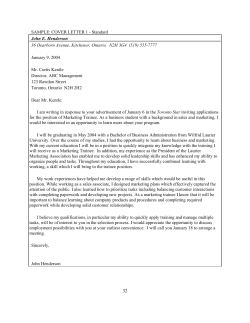
OJT Training Module Cover Sheet
OJT Training Module Cover Sheet Title: Type: 211 How to name a new soil series. Skill X Knowledge Performance Objective: Trainee will be able to— • • • • Select words from the local geography to use as potential new soil series names. Construct (i.e., coin) appropriate potential new names for soil series. Search the Soil Series Classification (SC) database for names of existing series. Compare potential new names to existing names to avoid problems. Target Proficiency: Awareness Understanding X Perform w/ Supervision Apply Independently Proficiency, can teach others Trainer Preparation: Provide Internet access for trainee to perform tasks in Steps 2, 3, and 4. Special Requirements: Initiate an external learning request with a SF-182 in Aglearn for this activity. Instructions and a template are located on the training webpages for OJT modules. Prerequisite Modules: • 208 How to use the Official Soil Series Descriptions web pages. • 209 Understand the Official Soil Series Description. • 210 How to develop a new soil series. Notes: None Authors: Joseph Chiaretti Approved by: Marc Crouch The Five-Step OJT Cycle for Declarative Training (Knowledge) Cycle Step 5 Trainer/Trainee debrief Cycle Step 4 Trainer observes Trainee perform task provided as feedback Cycle Step 1 Trainer/Trainee establish shared mental model Trainer and Trainee Cycle Step 3 Trainer and Trainee discuss information Cycle Step 2 Trainee reviews materials provided OJT Module Lesson Title: 211 How to name a new soil series. WHAT Cycle step 1 Cycle step 2 WHY, WHEN, WHERE, HOW, SAFETY, QUALITY The trainer and trainee review the objectives of this module. The trainer discusses with the trainee some of the common names for soil series in the MLRA and their naming history, if they are known. The trainee should access via the internet and read guidance on Proposing and Naming a Soil Series in NSSH part 614.06(c). The trainee pays special attention to the list of four reserved names mentioned in this section of the NSSH. The words “Aux”, “Con”, “Nul”, and “Prn” are reserved due to database constraints and cannot be used for soil series names. The trainee reviews the attached “Naming Soil Series.pdf” to view a specific example of a query operation used to test a potential new soil series name. The trainee also reads the notes for each slide in the presentation. The trainer decides which geographic spatial data he or she will have the trainee view for this step. Some possible sources of geographic data are paper copies of USGS topographic quadrangle maps, electronic files of digital raster graphics (DRGs), the Web Soil Survey application, and software, such as ArcGIS Explorer or Google Earth. Cycle step 3 The trainer asks the trainee to view the geographic data and select three named geographic features as potential soil series names. The trainee selects the names from such features as the names of towns, hills, mountains, lakes, or roads. Potential series names may also be coined by combining words or phrases found on maps or elsewhere. The trainee then accesses the Soil Series Classification Database (SC) Web page: (NRCS/Soils/Soil Classification/Soil Series Classification Database (SC)) Then trainee clicks the link labeled “Soil Series Name Search” followed by the hyperlinked word “wildcards” located above the text box. Cycle step 4 The trainee notes the four types of wildcard characters which may be used to query the SC database for existing soil series names. The characters are an asterisk (*), a question mark (?), a combination of left and right square brackets ([]), and a caret symbol enclosed by left and right square brackets ([^]). The purpose of querying the SC database for series names is to check potential new names for both present or prior usage. Present usage refers to a series with tentative or established status. Prior usage pertains to series which have inactive status. The trainee enters his or her chosen potential soil series names into the text box on the Soil Series Name Search Query Facility Web page and runs some queries using leading and trailing asterisk characters. Cycle step 5 The trainer discusses the query exercise with the trainee and answers any questions arising as a result of this module. OJT Module Lesson Measurement of Learning Title: 211 How to name a new soil series. WHAT WHY, WHEN, WHERE, HOW, SAFETY, QUALITY Trainee’s learning is measured. Have the trainee complete the attached quiz to reinforce the concepts presented in this module. Apply knowledge gained to current survey work. The trainee develops a short list of acceptable new soil series names for future use by local survey staff. SF-182 Trainee and/or supervisor access Aglearn to verify completion of the module via its SF-182. Quiz 1. What part of the National Soil Survey Handbook contains detailed guidance on naming a soil series? A) B) C) D) E) Part Part Part Part Part 609, 610, 614, 627, 630, Quality Control, Quality Assurance, and Soil Correlation Updating Soil Surveys Applying Soil Taxonomy Legend Development and Data Collection Benchmark Soils 2. True or False? The name of a local geologic formation is OK to use for a new soil series name if it is also the name of a local community. 3. What words are considered “reserved” and cannot be used for soil series names? A) B) C) D) E) Aux Con Nul Prn All of the above 4. What feature makes using the Soil Series Name Search Query Facility Web page easier and more powerful? A) B) C) D) A spell checking tool A “type-ahead” tool The “Clear form” button Wildcard characters 5. The name “Mountainmahogany” is a potential new soil series name. Is this name acceptable? A) Yes, since it is the name of a local plant in your survey area B) No, since it is the name of a plant C) Maybe, if you can convince your SDQS
© Copyright 2025









